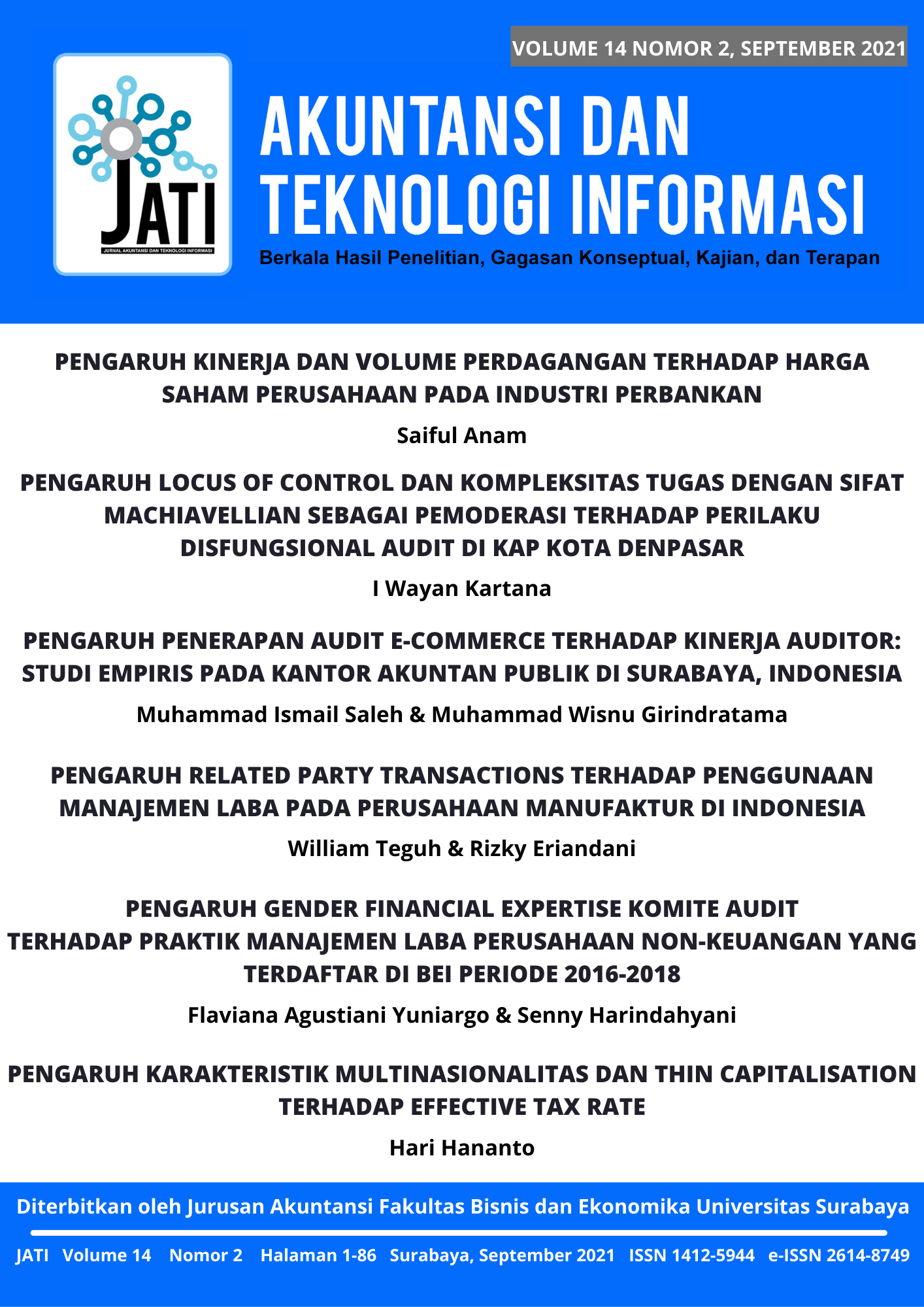PENGARUH KARAKTERISTIK MULTINASIONALITAS DAN THIN CAPITALIZATION TERHADAP EFFECTIVE TAX RATE
 Abstract Views:
797 times
Abstract Views:
797 times
 pdf Downloads:
855 times
pdf Downloads:
855 times
Abstract
The company always tries to minimize tax payments through various ways. In particular, a multinational company, has more ability to do tax avoidance. One technique that can be used by multinational corporations is to transfer corporate income from one jurisdiction to another that has a lower corporate income tax rate to minimize overall group tax payments. This mechanism can result in superior tax payments for multinational companies that have subsidiaries or affiliated companies. In addition to income transfer, multinational companies can also regulate their capital composition in order to take advantage of the ease of obtaining capital in a jurisdiction. This study aims to show empirical evidence about the effect of the nature of multinationality (multinational companies) and the existence of capitalization (thin capitalization) on the possibility of tax avoidance. The population sample used in this study were companies listed on the IDX during the 2017-2019 period. The results show that multinational companies have an effect on increasing tax avoidance efforts. Meanwhile, thin capitalization has no effect on efforts to increase tax avoidance.
Downloads
References
Aggarwal, R., & Kyaw, N. A. (2008). Internal capital networks as a source of MNC competitive advantage: Evidence from foreign subsidiary capital structure decisions. Research in International Business and Finance, 22(3), 409-439.
Base erosion and profit shifting - OECD BEPS. (2017). Retrieved 5 January 2021, from https://www.oecd.org/tax/beps/
Booth, L., Aivazian, V., Demirguc‐Kunt, A., & Maksimovic, V. (2001). Capital structures in developing countries. The journal of finance, 56(1), 87-130.
Chatterjee, Samprit; Simonoff, Jeffrey (2013). Handbook of Regression Analysis. John Wiley & Sons
Cristea AD, Nguyen DX (2016). Transfer pricing by multinational firms: New evidence from foreign firm ownerships. American Economic Journal: Economic Policy 8(3):170-202
Clausing KA (2015). The effect of profit shifting on the corporate tax base in the United States and beyond. Available at SSRN 2685442
Cochrane, D.; Orcutt, G. H. (1949). "Application of Least Squares Regression to Relationships Containing Auto-Correlated Error Terms". Journal of the American Statistical Association.
Dahlan, A. (2018). Treaty Shopping, Sebuah Upaya Penghindaran Pajak yang Patut Diwaspadai | Direktorat Jenderal Pajak. From https://www.pajak.go.id/artikel/treaty-shopping-sebuah-upaya-penghindaran-pajak-yang-patut-diwaspadai
Dharmapala, D. (2014). What do we know about base erosion and profit shifting? A review of the empirical literature. Fiscal Studies, 35(4), 421-448.
Dharmasaputra, M. (2014). Key Witness: An Investigation of Indonesia’s Largest Ever Tax Scandal. Indonesia: PT Tempo Inti Merdeka Harian, Jakarta
Desai, M. A., Foley, C. F., & Hines Jr, J. R. (2004). A multinational perspective on capital structure choice and internal capital markets. The Journal of finance, 59(6), 2451-2487.
Fuest, C., Spengel, C., Finke, K., Heckemeyer, J., & Nusser, H. (2013). Profit shifting and aggressive tax planning by multinational firms: Issues and options for reform. ZEW-Centre for European Economic Research Discussion Paper, (13-078).
Group, M. (2020). Understanding the Arm's Length Principles and the Consequences in Transfer Pricing. Retrieved 13 January 2021, from https://mucglobal.com/en/news/2271/understanding-the-arms-length-principles-and-the-consequences-in-transfer-pricing
Hejase A, Hejase H (2013). Research Methods: A Practical Approach for Business Students (2nd edition). Philadelphia, PA, USA: Masadir Inc
Howard V. Perlmutter, "The Tortuous Evolution of the Multinational Corporation," Columbia Journal of World Business, 1969, pp. 9-18.
Huizinga, H., & Laeven, L. (2008). International profit shifting within multinationals: A multi-country perspective. Journal of Public Economics, 92(5-6), 1164-1182.
Ištok, M., & Kanderová, M. (2019). Debt/asset ratio as evidence of profit-shifting behaviour in the Slovak Republic. Technological and Economic Development of Economy, 25(6), 1293-1308.
Kieso, D. E., Weygandt, J. J., & Warfield, T. D. (2020). Intermediate accounting IFRS. John Wiley & Sons.
Kim, K. A., & Limpaphayom, P. (1998). Taxes and firm size in Pacific-Basin emerging economies. Journal of international accounting, auditing and taxation, 7(1), 47-68.
Klassen, K. J., & Laplante, S. K. (2012). Are US multinational corporations becoming more aggressive income shifters?. Journal of Accounting Research, 50(5), 1245-1285.
Komunikasi, B. (2020). Kemenkeu Learning Center. Klc.kemenkeu.go.id. Retrieved 27 October 2020, from https://klc.kemenkeu.go.id/base-erosion-and-profit-shifting-beps/.
Lanis, R., & Richardson, G. (2013). Corporate social responsibility and tax aggressiveness: a test of legitimacy theory. Accounting, Auditing & Accountability Journal.
Maharani, I. G. A. C., & Suardana, K. A. (2014). Pengaruh Corporate Governance, Profitabilitas, dan Karakteristik Eksekutif pada Tax Avoidance Perusahaan Manufaktur. E-jurnal Akuntansi, 9(2), 525-539.
Model Tax Convention on Income and on Capital - Condensed Version (July 2010) - OECD. (2010). Retrieved 6 January 2021, from https://www.oecd.org/ctp/treaties/modeltaxconventiononincomeandoncapital-condensedversionjuly2010.htm
Modigliani, F., & Miller, M. H. (1963). Corporate income taxes and the cost of capital: a correction. The American economic review, 53(3), 433-443.
Noor, R.M.; N.S.M. Fadzillah; and N. Mastuki. 2010. “Corporate Tax Planning: A Study onCorporate Effective Tax Rates of Malaysian Listed Companies.” International Journal ofTrade, Economics and Finance 1, no. 2: 189–193.
Organisation for Economic Co-operation and Development (OECD) (2010). Transfer Pricing Guidelines for Multinational Enterprises and Tax Administration 2010, para.0.18. Paris: OECD Publishing.
OECD. (2013). Public Consultation: Draft Handbook On Transfer Pricing Risk Assessment. Paris: OECD Publishing
OECD. (2013). Public Consultation White Paper On Transfer pricing Documentation. Paris: OECD Publishing
OECD. (2012). Dealing Effectively with the Challenges of Transfer pricing, Paris: OECD Publishing
Omer, T.C.; K. Molloy; and D. Ziebart. 1993. “An Investigation of the Firm Size–Effective Tax Rate Relation in the 1980s.” Journal of Accounting, Auditing and Finance 8, no. 2: 167–182.
Ortax.org. 2021. Base Erosion and Profit Shifting, apa pengaruhnya bagi Indonesia? | Ortax - your center of excellence in taxation. [online] Available at: <https://www.ortax.org/ortax/?mod=issue&page=show&id=61&list=&q=&hlm=4> [Accessed 28 December 2020].
Pohan, C. A. (2016). Manajemen Perpajakan Strategi Perencanaan Pajak dan Bisnis Edisi Revisi. Jakarta: PT Gramedia Jakarta.
Porter, Michael E. 1986. Changing patterns of international competition. California Management Review, 28: 9-40.
PwC (2011). Transfer Pricing and Developing Countries - Final Report. EuropeAid - Implementing the Tax and Development policy agenda
Readhead, A. (2016). Transfer pricing in the mining sector in Zambia. Case Study.
Rego, S. O. (2003). Tax‐avoidance activities of US multinational corporations. Contemporary Accounting Research, 20(4), 805-833.
Richardson, G., Taylor, G., & Lanis, R. (2013). Determinants of transfer pricing aggressiveness: Empirical evidence from Australian firms. Journal of Contemporary Accounting & Economics, 9(2), 136-150.
Riyanto, Bambang. 2013. Dasar-dasar Pembelanjaan Perusahaan. Yogyakarta: BPFE
Root, F. R. (1994). Entry strategies for international markets. Jossey-Bass
Root, F. R., & Kramer, R. L. (1973). International trade & investment: theory, policy, enterprise (Vol. 77). South-Western Pub. Co.
Sembiring, E. R. (2005). Karakteristik Perusahaan dan Pengungkapan Tanggung Jawab Sosial. Studi Empiris pada Perusahaan yang terdaftar di Bursa Efek Jakarta. Simposium Nasional Akuntansi VIII. Solo.
Sugianto, D., 2019. Adaro Dituduh Hindari Pajak, DJP: Kita Pelajari. [online] detikfinance. Available at: <https://finance.detik.com/bursa-dan-valas/d-4612405/adaro-dituduh-hindari-pajak-djp-kita-pelajari?_ga=2.45839652.1219792938.1610775169-90508083.1601439597> [Accessed 19 December 2020].
Suqih, L. R., & Jasman, J. (2018). Profit Shifting Determinants And Tax Haven Utilization: Evidence From Indonesia. Russian Journal of Agricultural and Socio-Economic Sciences, 83(11).
Taylor, G., Richardson, G., & Lanis, R. (2015). Multinationality, tax havens, intangible assets, and transfer pricing aggressiveness: An empirical analysis. Journal of International Accounting Research, 14(1), 25-57.
Tax Haven Definition from Financial Times Lexicon. Web.archive.org. (2020). Retrieved 8 November 2020
"Tax haven definition and meaning | Collins English Dictionary". Collins Dictionary. Archived from the original on 28 December 2017. Retrieved 27 December 2017. A tax haven is a country or place which has a low rate of tax so that people choose to live there or register companies there in order to avoid paying higher tax in their own countries.” (2)
Thin capitalisation. (2020). Retrieved 4 February 2021, from https://www.ato.gov.au/Business/Thin-capitalisation/
Twesige, D., & Gasheja, F. (2019). Determinants of profit shifting by multinational companies in developing countries: A case of Rwanda. Journal of Accounting and Taxation, 11(4), 67-78.
Twesige, D., Gasheja, F., Barayendema, J., & Uwamahoro, A. (2020). Effect of Transfer Pricing on Profit Shifting by Multinational Companies in Developing Countries: A Case of Rwanda. In Rwandan Economy at the Crossroads of Development (pp. 149-167). Springer, Singapore.
Wolf, M. (2004). Globalisation and interdependence. Address to UN Outubro.
Wolf, M. (2004). Why globalization works (No. 3). Yale University Press.
Widowati, A. I. (2011). Faktor-Faktor yang Mempengaruhi Pelaporan Aset Tak Berwujud Pada Perusahaan yang terdaftar di BEI. Paper disajikan pada Seminar Nasional Update Ekonomi, Akuntansi dan Bisnis Indonesia.
- Copyright on articles is retained by the respective author(s), without restrictions. A non-exclusive license is granted to Akuntansi dan Teknologi Informasi (JATI) to publish the article and identify itself as its original publisher, along with the commercial right to include the article in a hardcopy issue for sale to libraries and individuals.
- Articles published in Akuntansi dan Teknologi Informasi (JATI) are licensed under a Creative Commons Attribution-ShareAlike 4.0 International license. You are free to copy, transform, or redistribute articles for any lawful purpose in any medium, provided you give appropriate credit to the original author(s) and the journal, link to the license, indicate if changes were made, and redistribute any derivative work under the same license.
- By publishing in Akuntansi dan Teknologi Informasi (JATI), authors grant any third party the right to use their article to the extent provided by the Creative Commons Attribution-ShareAlike 4.0 International license.

 DOI:
DOI:









